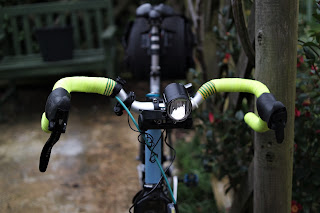Winter can chomp through
consumables, at an alarming rate. Pads are no exception and I’d bought
replacements, knowing the time was edging closer. Fade struck, along a
regularly traversed 1in7. Decision made. Pads stripped and replaced within
minutes of returning home.
These patterns lasted a year,
or so. Fixed relies less on mechanical braking, thus usefully extending pad and
related component life. Provided you’re not living in a particularly hilly
region, of course. I continue to be delighted by the Halo Fixed-G rear hub.
Perfect chainline also ensures a nigh on silent transmission. Acceleration
feels tangibly brisker, too. I’ve reached my conclusions regarding the Tioga
City Slicker tyres https://www.sevendaycyclist.com/tioga-city-slicker-tyres
Richard Peace has been putting
the Carrera cross city folding bike through its paces https://www.sevendaycyclist.com/carrera-crosscity-folding-electric-
Pad changing presented an
obvious opportunity to give the bike a deeper clean, than usual. The Velo 21 dirty weekend pre-wash did a
decent job. It’s a subtle formula that doesn’t foam, or anything visually
exciting. Science suggests the surfactants are doing the business. Eating into
the grime, rather than just foaming on the surface.
Suffice to say, it romped
through organic grot and slurry, without needing to agitate. Even petrochemical
based spatter slithered away, left marinating for five minutes and then rinsed.
These Soma Fabrications Condor II shallow drop bar also arrived this week, so I
wasted no time fitting them.
Elsewhere, having averted
potential castration, my Univega’s cassette was resembling one of those “fat
balls” supposedly breeding in our sewer systems. An obvious candidate for
Velo21 degreaser.
Chain, cassette, jockey wheels
and ring came up quite nicely too. Not without a fair bit of elbow grease. It’s
worth noting that Stealth, is a very stoical ceramic. I’ll need to see how it
works on less tenacious lubes, before passing appropriate, fair comment.
I also checked the chain’s
health, using this digital chain checker. Budget analogue units are dirt cheap,
accurate enough too. However, I prefer the pin-point, in a glance confirmation.
Chains don’t stretch, they wear. Consign to the bin, once wear measures 0.8mm.
Time spent undertaking regular
inspections and preventative maintenance is priceless. Aside from extending the
life of expensive components, I’d rather be out, enjoying the miles than fixing
stuff by the road/trailside. Let alone the long walk home.
This housekeeping also proved
the ideal opportunity to fit the Easton EVA wrap and swap back to the Schwalbe
Marathon Mondial https://www.sevendaycyclist.com/schwalbe-marathon-mondial-tyres
, now the threat of ice, has greatly diminished. https://www.sevendaycyclist.com/after-the-gritters-went-home
Bored with Brexit, red top
tabloids have now fixated on extreme weather. Coastal flooding now tops the
agenda.
After some casual, late night
trawling, I came across an Alivio rear mech, to replace the long serving
Microshift M45. Crucially it was of a higher spec, and at the right price. I’ve
stripped, cleaned and inspected the M45 and there’s surprisingly little slop.
I changed the cable and closer
inspection revealed the SRAM chain was fit for the knackers’ yard, cassette not
far behind (though thankfully, I already had an 11-28) so retired both.
Worth buying a stock of both,
if you do big mileages and/or ride in harsh conditions. However, as I’ve said
before, there’s a fine line between sensible stock-piling and hoarding.
Cassette lock-rings can become
very stubborn, even when they’ve been given a lick of stiff grease. The 11-30
Sram was no exception, benefitting from a quick blast of penetrant spray.
11-28 tooth electroplated Sram
replacement on the freehub body and lock ring greased, I torqued it to 40nms,
reinstated the wheel, then cut and fitted the new chain. I ordered two, so
there’s one on tap, when the chain checker chimes 0.8mm.
While the other 9spd
components are in solid shape, I’ll stick to this grade of rear mech and consumables.
Unless I’m presented with an interplanetary (hub gear) system, I’ll probably
upgrade to ten speed. An Octalink crankset, Deore mech and Sun Race brifters
seem good options. The production Alpina 506’s factory specification, was a mix
of Shimano LX and XT.
At present, it’s an eclectic
mix of Ultegra, Deore, 105 (equivalent) and some slightly lower end but
extremely serviceable parts. Components that make it go and stop in excellent
proportion. I’m a constant tinkerer, and some would say, contrary figure. Who knows what will follow…


























